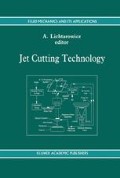Abstract
In this paper we investigated the correlation between operational parameters of abrasive waterjet machining and the kerf geometry. A series of factorial experiments involving cutting and grooving of steel aluminum and titanium samples were carried out. The results of experiments were used to construct appropriate regression equations. The linearity of the effects of principal process parameters on the kerf dimensions was demonstrated and a practical technique for prediction of the depth of cut was suggested.
Access this chapter
Tax calculation will be finalised at checkout
Purchases are for personal use only
Preview
Unable to display preview. Download preview PDF.
Abbreviations
- Pi:
-
Initial water pressure (MPa)
- Po:
-
Operating water pressure (MPa)
- Pth:
-
Water pressure threshold (MPa)
- Do:
-
Diameter of water nozzle orifice (mm)
- Dt:
-
Diameter of focusing tube (mm)
- Sa:
-
Size of abrasive (μm)
- Ma:
-
Abrasive flow rate (g/min)
- Sd:
-
Stand-off distance (mm)
- U:
-
Traverse speed (cm/min)
- H:
-
Depth of cut (mm)
- Wt:
-
Top kerf width (mm)
- Wb:
-
Bottom kerf width (mm)
- Tp:
-
Taper of kerf (degree)
References
P.A. Tichomirov et al, Hvdrocutting of Shipbuilding Materials, Sudostroenie, Leningrad, 1987, pp.37 (in Russian).
Hashish, M., Visualization of the Abrasive-Waterjet Cutting Process, Experimental Mechanics, Jun. 1988, pp. 159–169.
Geskin, E.S.; Chen, W.L.; Chen, S.S.; Hu, F.; Khan M.E.H.; Kim, S.; Singh, P.and Ferguson, R., Investigation of Anatomy of Abrasive Waterjet, Proceedings of the 5th American Water Jet Conference, Toronto, August 1989, pp. 217–230.
Hashish, M., A Model for Abrasive-Waterjet (AWJ) Machining, ASME Journal of Engineering Materials and Technology, Apr. 1989, Vol. 111, pp. 154–162.
Blickwedel, H.; Guo, N.S.; Haferkamp, H. and Louis, H., Prediction of Abrasive Jet Cutting Efficiency and Quality, Proceedings of the 10th International Symposium on Jet Cutting Technology, Amsterdam (1990).
Hu, F., Yang, Y., Geskin, E.S. and Chung, Y., Characterization of Material Removal in the Course of Abrasive Waterjet Machining, Proceedings of the 6th American Water Jet Conference. Houston (1990), pp.17–29.
Matsui, S.; Matsumura, H.; Ikemoto, Y.; Kumon, Y. and Shimizu, H., Prediction Equations for Depth of Cut Made By Abrasive Water Jet, Proceedings of the 6th American Water Jet Conference. Houston (1991), pp. 31–41.
Mazurkiewicz, M., A Study of a Leading Edge Profile for a Slot Formed During Hydro-Abrasive Cutting, Proceedings of the 6th American Water Jet Conference, Houston (1990), pp. 43–59.
Zeng, J.; Heines, R. and Kim, T.J., Characterization of Energy Dissipation Phenomenon in Abrasive Waterjet Cutting, Proceedings of the 6th American Water Jet Conference, Houston (1990), pp. 163–177.
Kovacevic, R., Surface Texture in Abrasive Waterjet Cutting, Journal of Manufacturing Systems, Jan. 1991, Vol. 10, No. 1, pp. 32–40.
Hu, F., Investigation of Material Erosion by Abrasive Waterjet Cutting, Master thesis, May 1990.
Hashish, M., Pressure Effects in Abrasive-Waterjet (AWJ) Machining, ASME Journal of Engineering Materials and Technology, Jul. 1989, Vol. 111, pp. 221–228.
Chalmers, E.J., Effect of Parameter Selection on Abrasive Waterjet Performance, Proceedings of the 6th American Water Jet Conference, Houston (1990), pp.345–354.
Chen, W.L. and Geskin, E.S., Correlation Between Particle Velocity and Conditions of Abrasive Waterjet Formation, Proceedings of the 6th American Water Jet Conference, Houston (1990), pp.305–313.
Hashish, M., Steel Cutting with Abrasive Water Jets, Proceedings of the 6th International Symposium on Jet Cutting Technology, University of Surrey, U.K. (1982), Paper K3.
Louis, H., Personal communcation, Hannover, Germany, July, 1989.
Beyer, W.H., Handbook of Mathematical Sciences, 6th edition, CRC press., pp.700.
Author information
Authors and Affiliations
Editor information
Editors and Affiliations
Rights and permissions
Copyright information
© 1992 Springer Science+Business Media Dordrecht
About this chapter
Cite this chapter
Chung, Y., Geskin, E.S., Singh, P.J. (1992). Prediction of the Geometry of the Kerf Created in the Course of Abrasive Waterjet Machining of Ductile Materials. In: Lichtarowicz, A. (eds) Jet Cutting Technology. Fluid Mechanics and Its Applications, vol 13. Springer, Dordrecht. https://doi.org/10.1007/978-94-011-2678-6_35
Download citation
DOI: https://doi.org/10.1007/978-94-011-2678-6_35
Publisher Name: Springer, Dordrecht
Print ISBN: 978-94-010-5185-9
Online ISBN: 978-94-011-2678-6
eBook Packages: Springer Book Archive

